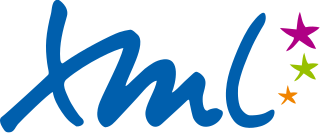Related Research Articles

LaTeX is a software system for typesetting documents. LaTeX markup describes the content and layout of the document, as opposed to the formatted text found in WYSIWYG word processors like Google Docs, LibreOffice Writer, and Microsoft Word. The writer uses markup tagging conventions to define the general structure of a document, to stylize text throughout a document, and to add citations and cross-references. A TeX distribution such as TeX Live or MiKTeX is used to produce an output file suitable for printing or digital distribution.

A markuplanguage is a text-encoding system which specifies the structure and formatting of a document and potentially the relationships among its parts. Markup can control the display of a document or enrich its content to facilitate automated processing.

In computing, plain text is a loose term for data that represent only characters of readable material but not its graphical representation nor other objects. It may also include a limited number of "whitespace" characters that affect simple arrangement of text, such as spaces, line breaks, or tabulation characters. Plain text is different from formatted text, where style information is included; from structured text, where structural parts of the document such as paragraphs, sections, and the like are identified; and from binary files in which some portions must be interpreted as binary objects.

The Standard Generalized Markup Language is a standard for defining generalized markup languages for documents. ISO 8879 Annex A.1 states that generalized markup is "based on two postulates":
troff, short for "typesetter roff", is the major component of a document processing system developed by Bell Labs for the Unix operating system. troff and the related nroff were both developed from the original roff.

Extensible Markup Language (XML) is a markup language and file format for storing, transmitting, and reconstructing arbitrary data. It defines a set of rules for encoding documents in a format that is both human-readable and machine-readable. The World Wide Web Consortium's XML 1.0 Specification of 1998 and several other related specifications—all of them free open standards—define XML.
DocBook is a semantic markup language for technical documentation. It was originally intended for writing technical documents related to computer hardware and software, but it can be used for any other sort of documentation.
The Document Style Semantics and Specification Language (DSSSL) is an international standard developed to provide stylesheets for SGML documents.

GNU TeXmacs is a scientific word processor and typesetting component of the GNU Project. It originated as a variant of GNU Emacs with TeX functionalities, though it shares no code with those programs, while using TeX fonts. It is written and maintained by Joris van der Hoeven and a group of developers. The program produces structured documents with a WYSIWYG user interface. New document styles can be created by the user. The editor provides high-quality typesetting algorithms and TeX and other fonts for publishing professional looking documents.

Typesetting is the composition of text for publication, display, or distribution by means of arranging physical type in mechanical systems or glyphs in digital systems representing characters. Stored types are retrieved and ordered according to a language's orthography for visual display. Typesetting requires one or more fonts. One significant effect of typesetting was that authorship of works could be spotted more easily, making it difficult for copiers who have not gained permission.
In computing, a polyglot is a computer program or script written in a valid form of multiple programming languages or file formats. The name was coined by analogy to multilingualism. A polyglot file is composed by combining syntax from two or more different formats.
Pretty-printing is the application of any of various stylistic formatting conventions to text files, such as source code, markup, and similar kinds of content. These formatting conventions may entail adhering to an indentation style, using different color and typeface to highlight syntactic elements of source code, or adjusting size, to make the content easier for people to read, and understand. Pretty-printers for source code are sometimes called code formatters or beautifiers.

Texinfo is a typesetting syntax used for generating documentation in both on-line and printed form with a single source file. It is implemented by a computer program released as free software of the same name, created and made available by the GNU Project from the Free Software Foundation.
Generalized Markup Language (GML) is a set of macros that implement intent-based (procedural) markup tags for the IBM text formatter, SCRIPT. SCRIPT/VS is the main component of IBM's Document Composition Facility (DCF). A starter set of tags in GML is provided with the DCF product.
Brian Keith Reid is an American computer scientist. He developed an early use of a markup language in his 1980 doctoral dissertation. His other principal interest has been computer networking and the development of the Internet.
SCRIPT, any of a series of text markup languages starting with Script under Control Program-67/Cambridge Monitor System (CP-67/CMS) and Script/370 under Virtual Machine Facility/370 (VM/370) and the Time Sharing Option (TSO) of OS/VS2; the current version, SCRIPT/VS, is part of IBM's Document Composition Facility (DCF) for IBM z/VM and z/OS systems. SCRIPT was developed for CP-67/CMS by Stuart Madnick at MIT, succeeding CTSS RUNOFF.
A structured document is an electronic document where some method of markup is used to identify the whole and parts of the document as having various meanings beyond their formatting. For example, a structured document might identify a certain portion as a "chapter title" rather than as "Helvetica bold 24" or "indented Courier". Such portions in general are commonly called "components" or "elements" of a document.

An XML transformation language is a programming language designed specifically to transform an input XML document into an output document which satisfies some specific goal.
SGMLguid, also known as "CERN SGML", "Waterloo based SGML", and "Waterloo SGML", was an early SGML application developed and used at CERN between 1986 and 1990. It served as a model of the earliest HTML specifications.
References
- 1 2 "1982 – Brian K. Reid". Grace Murray Hopper Award . Retrieved 2009-02-24.
For his contributions in the area of computerized text-production and typesetting systems, specifically Scribe which represents a major advance in this area. It embodies several innovations based on computer science research in programming language design, knowledge-based systems, computer document processing, and typography.
- ↑ "Scribe(ID:2481/scr010) - Text-formatting language". Online Historical Encyclopaedia of Programming Languages (hopl.info). Retrieved 2009-02-24.
Brian Reid. Ground-breaking text-formatting language. Reason for Reid getting a Hopper Medal in 1982.
- ↑ "Markup Technologies '98 Conference. Agenda and Schedule". xml.coverpages.org. November 1998. Retrieved 2009-02-24.
Brian Reid's work with markup systems began in the 1970s. He independently invented and implemented descriptive markup and developed its theory. His Scribe system may have been the cleanest separation of structure and format ever built. His dissertation on it was already complete in 1981, the year he presented in Lausanne in the same session where Charles Goldfarb publicly presented GML; SGML was proposed about a year later
- ↑ "XML Linking". xml.indelv.com. November 1998. Retrieved 2009-02-24.
"Generalized", "generic", or "descriptive" markup has been discovered several times, apparently independently. Scribe [Reid 1981] is an early formatter based on structure rather than formatting commands.
- ↑ Brian K. Reid, "A high-level approach to computer document formatting", Proceedings of the POPL '80 Proceedings of the 7th ACM SIGPLAN-SIGACT symposium on Principles of programming languages, p. 24-31 doi : 10.1145/567446.567449
- ↑ see GML Wiki article
- ↑ PostScript Printer Driver Optimization Case Study , Adobe Systems, Technical Note #5042, 31 March 1992. Page 5.
- ↑ The Chronicle: August 10, 2001: 2 Scholars Face Off in Copyright Clash
- ↑ Williams, Sam (March 2002). "Free as in Freedom - Richard Stallman's Crusade for Free Software". O'Reilly . Retrieved 2008-09-26.
For Reid, the deal was a win-win. Scribe didn't fall into the public domain, and Unilogic recouped on its investment. For Stallman, it was a betrayal of the programmer ethos, pure and simple. Instead of honoring the notion of share-and-share alike, Reid had inserted a way for companies to compel programmers to pay for information access.
- ↑ TexInfo
- ↑ Crockford, Douglas (2007-06-28). "Scribe" . Retrieved 2010-04-12.